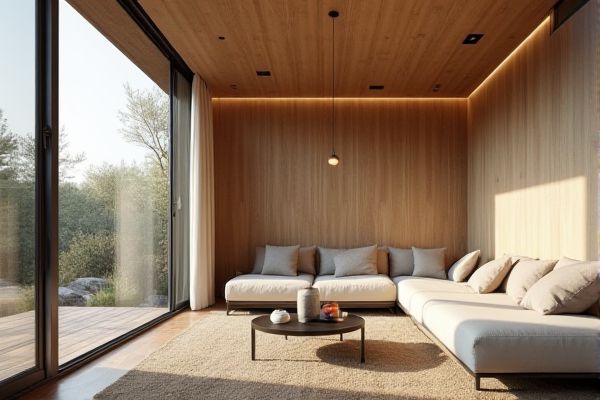
Open rise allows your bread dough to expand freely during fermentation, resulting in a lighter, airier texture, while solid rise involves a denser dough structure that yields a firmer, more compact crumb. Discover which rising method suits your baking style and how it affects the final bread quality by reading the rest of the article.
Table of Comparison
| Feature | Open Rise | Solid Rise |
|---|---|---|
| Design | Gap between steps, open structure | Closed risers, solid vertical panels |
| Light & Space | Allows light flow, creates spacious feel | Blocks light, provides solid appearance |
| Safety | Less safe for children and pets | Safer, no open gaps |
| Cost | Generally lower cost | Often higher cost due to materials |
| Noise | More noise from foot traffic | Quieter, better sound insulation |
| Style | Modern, minimalist look | Traditional and classic appearance |
Introduction to Staircase Rises
Open rise staircases feature gaps between steps, enhancing light flow and creating an airy, modern aesthetic ideal for contemporary interiors. Solid rise staircases have closed risers, offering a traditional, sturdy appearance that increases privacy and minimizes noise transmission. Choosing between open and solid rises depends on desired visual impact, safety considerations, and space functionality within the building design.
What is an Open Rise?
An Open Rise in roofing refers to a design where the roof slope extends uninterrupted from the eave to the ridge, allowing for continuous ventilation and natural light. This configuration enhances airflow, reducing moisture buildup and improving indoor air quality. Open Rise roofs are often favored in structures requiring efficient ventilation, such as barns and greenhouses.
What is a Solid Rise?
A solid rise refers to the smooth, continuous increase in a wave's height during its formation, characterized by uniform energy buildup without abrupt changes or breaks. This contrasts with an open rise, where the wave's crest has already started to break, leading to a foamy, turbulent surface. Understanding the difference helps you predict wave behavior for better performance in surfing, kayaking, or coastal activities.
Key Design Differences
Open rise flutes feature a continuous, unbroken flute running along the tool's edge, enhancing chip evacuation and reducing heat buildup during cutting. Solid rise flutes consist of segmented or interrupted cuts, providing increased stability and strength, especially in heavy-duty or high-torque applications. The design choice directly affects tool performance, with open rise prioritizing efficient chip flow and solid rise offering enhanced durability and resistance to tool wear.
Aesthetic Appeal of Open vs Solid Rise
Open rise staircases enhance aesthetic appeal by creating a sense of openness and allowing light to flow freely, contributing to a modern and airy atmosphere. Solid rise stairs offer a more traditional and sturdy appearance with a clean, continuous silhouette that complements classic and formal interiors. Homeowners seeking to maximize visual space often prefer open rise designs, while those aiming for durability and a grounded look opt for solid rise options.
Structural Stability and Safety
Open rise staircases offer enhanced structural stability due to their continuous stringer support, reducing lateral movement and increasing load-bearing capacity. Solid rise staircases provide superior safety by eliminating gaps between steps, preventing tripping hazards and improving overall foot support. Both designs require proper material selection and installation to maximize durability and compliance with building safety codes.
Cost Comparison: Open Rise vs Solid Rise
Open rise bed frames typically cost less than solid rise frames due to simpler construction and fewer materials used. Solid rise beds offer enhanced durability and support, often resulting in a higher price point reflecting their robust design. When choosing your bed frame, consider the balance between budget and longevity to find the best value.
Installation and Maintenance Considerations
Open rise systems simplify installation by providing easier access to pipes, reducing labor time and costs during setup. Maintenance is more straightforward with open rise configurations, allowing quick visual inspections and repairs without dismantling walls or ceilings. In contrast, solid rise systems require careful planning during installation due to concealed pipes, increasing complexity and potential expenses during future maintenance.
Best Applications for Each Type
Open rise hinges are best suited for doors that require wide openings and enhanced ventilation, making them ideal for commercial kitchens, retail spaces, or rooms with high foot traffic. Solid rise hinges provide a firmer, more discreet pivot, perfect for residential interior doors, cupboards, or cabinetry where noise reduction and aesthetic continuity are priorities. Selecting the right hinge type depends on balancing door accessibility needs with the desired level of structural support and design integration.
Choosing the Right Rise for Your Space
Selecting the right rise between open rise and solid rise staircases depends on both aesthetic goals and safety requirements. Open rise stairs create an airy, modern look that enhances spatial openness, ideal for smaller or contemporary interiors, while solid rise stairs provide a traditional, sturdy feel with enhanced privacy and noise reduction. Consider factors such as foot traffic, visibility, and design harmony to determine the most suitable rise type for your space.
 homyna.com
homyna.com